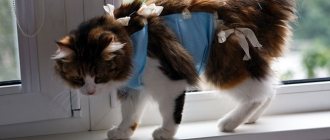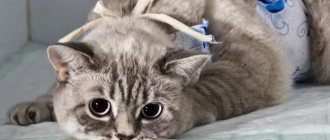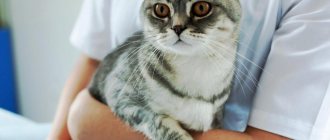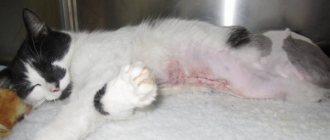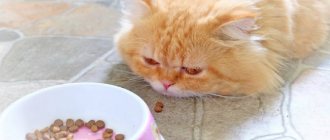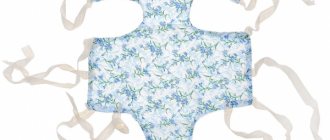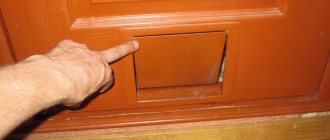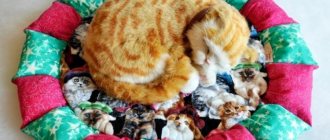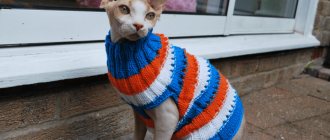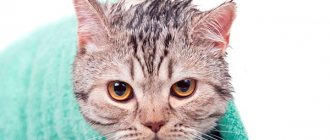The suture during sterilization of cats can be quite large when performing surgery along the white line of the abdomen, small (no more than 1 cm) when sterilizing using the lateral incision method, and practically invisible when sterilizing using laparoscopy. The veterinary specialist who performed the surgery will explain what the stitch should be after sterilizing the cat.
Depending on the chosen surgical technique, the size of the seam will differ. As a rule, sutures are placed when cutting the muscle layers and skin during sterilization along the white line of the abdomen.
This technique is widely used when removing the uterus and ovaries (ovariohysterectomy). When only the ovaries are removed, more gentle techniques are used that do not require a large number of stitches, or are absent altogether (with laparoscopy).
Internal sutures are placed on the muscle layers using self-absorbable suture material, and external sutures are sutured with surgical threads, which must later be removed.
Depending on what kind of suture the cat has after sterilization, the rate of tissue regeneration will depend. It is important to note that during the entire postoperative period the suture should remain clean and as dry as possible.
If any pathological changes are detected - suppuration, inflammatory processes or bloody discharge, you must contact a veterinary clinic in order to avoid serious complications.
How many days after surgery should stitches be removed?
It all depends on the specific case. The condition of the postoperative wound plays a huge role.
By the time the suture material is removed, it must meet the following requirements:
- The cut line may be rough, the stitches of the sutures are clearly visible, but the presence of bloody discharge, blood crusts or exudate is unacceptable.
- You need to feel the seam. If everything is in order and the suture material can be removed, then the local temperature will be normal.
- Swelling and redness of the postoperative wound are also unacceptable.
As a rule, the suture reaches this state by the tenth day after surgery, in some cases you have to wait two or three weeks (this does not happen often).
How many days after endoscopic surgery can the suture be removed? The suture is rarely longer than five millimeters; there is no need to rush to remove it. Haste can leave the animal's abdominal cavity open to bacterial contamination.
Care plan: first week day by day
After sterilization, doctors give a list of recommendations for caring for your pet.
Requirements depend on the time that has passed since the operation:
- 1st day. The cat comes out of anesthetized sleep for several hours. During this period, she is in an inadequate state: she tries to crawl away, shows aggression, and meows. It is necessary to limit the movement of your pet until coordination is restored. To eliminate pain, give an injection prescribed by a veterinarian. No feeding, only water.
- 2nd day. The animal is in pain and shows aggression or tries to hide. At this time, the pet makes its first attempts to lick the seam. You need to give painkillers or give an injection. You can start feeding in small portions.
- 3rd day. The condition is improving and there is almost no pain. The animal becomes active, asks for food, goes to the litter box. You should measure the temperature and if it increases or decreases, consult your veterinarian.
- 4th day. The pet eats and goes to the tray on its own. Despite the appearance of an appetite, it is impossible to overfeed a cat - after sterilization, animals tend to become obese.
- 5th day. The stitch is showing signs of scarring and is not painful. The cat can be allowed to walk around the apartment and jump on low surfaces.
- 6th day. No pain. The animal is active, eats well and goes to the tray.
- 7th day. The stitches are removed.
If the rehabilitation plan is followed, the pet will quickly recover after sterilization.
Do I need to remove stitches at all?
Here everything depends on the characteristics of the suture material used during the operation. Today, veterinarians all over the world are trying to use varieties that dissolve on their own. But this doesn't always happen.
In addition, even material that is “digested” by the animal’s body is not immediately absorbed. The stitches left on the animal's skin are disturbing and irritating. Therefore, the cat will constantly itch and chew its belly. All this may well lead to the development of an inflammatory reaction.
Many veterinary specialists clearly answer that sutures should be removed regardless of the suture material used.
This will save you from many problems in the future. Please note that this only applies to external seams. Sutures placed on the peritoneum dissolve perfectly.
Leptospirosis
Transmitted through raw meat of rodents and wild animals. At the beginning there are no symptoms, the incubation period lasts up to 10 days, but can be shortened by stress factors, such as surgery.
Characteristic symptoms of blood poisoning develop:
- There is a strong increase in temperature by 2-3 and even 4oC.
- In the process of life, leptospires destroy red blood cells, so free hemoglobin easily seeps through the tissues. This causes the urine to become brown or dark brown in color.
- The feces become liquid, black or dark cherry, sometimes with a greenish tint, and take on the smell of rotten meat.
- The mucous membranes acquire a yellowish tint.
- In this case, microscopic hemorrhages in the form of red dots can be detected in the oral cavity.
- Later they grow, merge together and form non-healing ulcers.
- The liver increases in size, becomes dense and painful.
Is it possible to remove stitches at home?
Yes, this is quite possible. Moreover, it is at home that sutures are usually removed. As a rule, there is no need to take the cat to the clinic for this procedure, since all the necessary manipulations can be performed independently without any problems.
Moreover, if your pet has a choleric type of character (i.e., is overly nervous), then you shouldn’t bother her with a trip to the clinic.
For everything to go well, you need to prepare the following things:
- A stable and fairly stable table with a flat surface.
- Oilcloth and several diapers.
- Sharp nail scissors and tweezers.
- Alcohol tincture of iodine or brilliant green.
Most likely, everything you need can be found in any home without any problems; no special devices are required for removing sutures.
Viral infection
It is not entirely correct to call a viral infection a complication of sterilization. But I want to warn as many people as possible. Doctors try to maintain cleanliness and order in the clinic to the best of their ability. However, your cat may still encounter viruses brought in by other cats. It is better if she is vaccinated in advance. The ideal regimen is vaccination at 3 months and sterilization between 6-12 months. Then revaccination at 15 months, when the cat has fully recovered from the operation.
Alarming signs of various viral diseases (rinotracheitis, calicivirosis, panleukopenia):
- Excessive drooling;
- Ulcer on the nose, tongue;
- Nasal discharge, sneezing;
- lacrimation;
- Vomiting or diarrhea;
- Depression, refusal to eat.
If your animal feels unwell, it is better to call your doctor and discuss the course of action. Sterilization itself cannot cause poor appetite, loose stools or other symptoms.
Preparing to remove sutures
First you need to assess the “mental state” of your pet. If for some reason the cat shows nervousness or aggression, then it is better to wait until the stitches are removed or consult a veterinarian.
Perhaps a specialist will be able to recommend some mild sedatives that have a calming effect. With their help, it will be much easier to remove stitches even in an easily excitable and aggressive cat.
Preparation is carried out as follows:
- First you need to take care of good lighting. Working in semi-darkness is not a good idea. It is advisable that the lighting be from above: in this case there will be fewer shadows and the task of removing seams will be easier.
- If the cat is a representative of long-haired breeds, it is necessary to trim off the excess fur covering the seam line. The less hair there is, the less likely it is that hairs will get into the wrong place.
- At the same time, boil the scissors and tweezers that will be used to remove the suture material thoroughly (for at least half an hour). If it is impossible to boil the instruments for some reason, you should at least wash them with warm water and soap (or wipe them thoroughly with medical alcohol).
- After this, wipe the seam line with warm soapy water. This is necessary to remove dirt and pieces of fur from the animal’s skin. In addition, after treatment the seams will soften somewhat, making them much easier to remove.
Exacerbation of glomerulonephritis
Glomerulonephritis refers to inflammation of the kidneys, which mainly affects the glomerular apparatus of the organ. Chronic glomerulonephritis is a dangerous pathology, since it involves gradual death of the renal glomeruli, which reduces the performance of organs.
The occurrence of a chronic form can be caused by autoimmune disorders. Pathology can develop due to autoimmune processes, hypothermia, chronic endometritis, and nutritional deficiency. One of the reasons is toxicosis, which can occur after anesthesia.
Chronic infectious diseases are also the cause:
- glanders;
- tuberculosis;
- chronic purulent bronchopneumonia;
- chroniosepsis.
During anesthesia, an exacerbation of the disease may occur, since narcotic drugs are excreted by the kidneys. In addition, edema develops, and an increased content of proteins, nitrogen, and creatine is observed in the urine. In severe cases, urine production stops, nitrous acids accumulate in the blood, and uremia, cachexia, and tachycardia are observed.
Step-by-step instructions for removing sutures
Here are step-by-step instructions that must be strictly followed when removing suture material:
- Before starting work, you need to wait about ten minutes so that the soapy water, which we already talked about above, has time to soften the suture material.
- After this, you must definitely count how many stitches were placed. If possible, you should also call the veterinarian who performed the spay and ask how many stitches he used. This is necessary so as not to accidentally leave a couple of stitches. This, by the way, does not happen so rarely.
- You can start withdrawing. First, you need to thoroughly wipe the tweezers with alcohol, and then carefully grab the seam loop. It should be pulled upward as much as possible.
- As soon as the seam has stretched sufficiently, you need to insert the lower jaw of the scissors under it and cut the thread.
- To remove the remainder of the latter, you need to pull it out of the skin. This is done carefully and without unnecessary haste. If the thread is “stuck” to the skin, it is necessary to carefully turn it around its axis and pull the rest of the seam towards you. If you pull too hard, you can injure your cat, tearing the thin layer of newly healed skin.
If the seam does not give way, and a piece of thread comes out of the skin with great difficulty, there is no need to rush and tear it out “forcibly”. You can wipe the grout line again with warm soapy water and wait about an hour. After this period, the skin will soften, after which everything can be done without much effort.
Safety rules when removing sutures
In order not to endanger the life and health of the cat, the owner who decides to remove the stitches himself must strictly follow the safety rules below:
- It is not recommended to remove stitches unless they have been examined by a veterinarian first . Only an experienced specialist will be able to tell how well the postoperative wound has healed and how safe it will be to remove the suture material.
- It is forbidden to remove sutures if the suture line is “inflated” , inflamed, numerous areas of redness are observed, and the local temperature in these places is significantly increased. These signs indicate a strong inflammatory response. In such cases, you should call your veterinarian immediately.
- In cases where there is bleeding (even a drop), or the release of exudate (regardless of the volume of the latter), the sutures are also prohibited from being removed.
Remember! Even if none of the above is observed, but the cat is behaving strangely and nervously, it is better to have it examined by a veterinarian first.
Diagnostics
If blood is detected in a cat's urine, the diagnosis is made based on the history provided by the owner and data from laboratory tests of urine and blood. The presence of purulent exudate, pathogenic microflora, and indicators of the level of erythrocytes and leukocytes are determined.
Urine sampling is carried out in the morning, no earlier than 3-4 hours before submitting the sample for analysis. Before this, it is not recommended to feed the cat for 12 hours.
To make an accurate diagnosis, in addition to laboratory tests, your pet may undergo an X-ray and/or ultrasound examination of the urinary system.
Safety precautions for the pet owner
During the procedure, the owner should worry not only about the safety of his pet. The health of the person undergoing the suture removal procedure may also be at risk. This is due to the fact that cats are rarely delighted with the fact that someone is “poking” their skin with tongs.
As a rule, removing stitches is not the most pleasant procedure; severe discomfort is possible. To minimize the likelihood that your pet will tear your hands until they bleed, you need to take the following steps:
If possible, call your veterinarian. The specialist may recommend some mild sedatives. Under their influence, the animal will become calmer, and therefore it will be easier for the owner to cope with it.
Please note that cat sterilization itself can be carried out using the same medications. If you reintroduce them a few days after the operation, the animal’s body will have a very hard time (the so-called cumulative effect will play a role). Thus, in this case it is necessary to select other sedatives. This will avoid unpleasant consequences.
However, you can cope without “chemistry”, but this will require an assistant. Just remember that you will have to hold the animal quite firmly.
Using a protective blanket and collar
A blanket is a special cotton garment that has cutouts for the paws and is fastened on the animal's back with Velcro or ties. They wear such a vest from the moment of sterilization until the wound heals.
A protective blanket is necessary to isolate the surgical site from sources of infection.
The collar is attached to the neck and limits the cat's movements towards the body. She will not be able to lick herself and touch the wound.
What to do if the cat removed the stitches on its own?
The situation when the cat removed the stitches itself is not uncommon in veterinary practice. Unfortunately, nothing good should be expected from such initiative, but there is still a chance for a successful outcome. They increase if the animal has its stitches removed closer to the date of their “official” removal.
If this happened in the first days after the operation, then the owner does not have much choice: he needs to urgently call the veterinarian.
The following signs indicate a high probability of severe complications:
- Heavy bleeding.
- Torn, torn edges of a postoperative wound.
- Easily visible internal organs visible through the disturbed wound channel.
Let us repeat once again - in such cases you need to immediately call a veterinarian. If the bleeding is severe, it is necessary to take the cat to the nearest clinic, but we would recommend waiting for a specialist at home. Transporting a cat with such injuries is very dangerous, and the pet may simply not survive until medical attention is provided.
Medicines: analgesics, suture antiseptics, antibiotics, vitamins
In the first 2 days you will need to give analgesics . The fact that the postoperative wound hurts is indicated by a change in the animal’s behavior. The cat shows aggression, meows, and refuses to move.
Be sure to read:
Can neutered cats mate with cats: why sexual heat remains, what to do
Analgesics will be required for the first 2 days.
Doctors recommend using painkillers:
- Ketoprofen (1% solution). The injection is given subcutaneously or intramuscularly once a day. The dose is calculated at 0.2 ml per kg of weight. Inject no more than 4 times.
- Tolfedine (tablets). Given with food. Dosage: 4 mg per kg.
- Meloxicam (suspension). On the first day, give 0.1 mg/kg, and in subsequent days, reduce the dose by half and give 0.05 mg/kg.
To treat sutures, veterinarians advise using:
- chlorhexidine 0.05%;
- Dioxidin 0.5%;
- Chemi spray;
- Vetericin spray.
During the recovery period after sterilization, antibacterial drugs are not prescribed. Antibiotics may be required if postoperative complications occur and an inflammatory process is detected.
For treatment use:
- Amoxicillin 15%. 1 ml/kg once a day for 5 days subcutaneously or intramuscularly.
- Sinulox. 0.5 ml/kg intramuscularly for 3-5 days.
Vitamins and restoratives are given only to old or weakened individuals. Gamavit is prescribed at 0.05 ml/kg for the first 3 days, and then the dose is increased to 0.1 mg/kg and given for 2 weeks.
